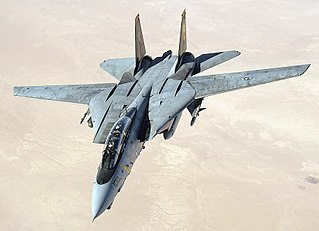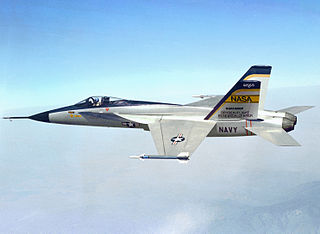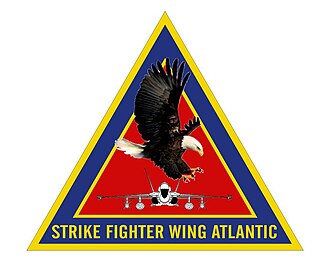
The AIM-120 Advanced Medium-Range Air-to-Air Missile, or AMRAAM, is a modern American beyond-visual-range air-to-air missile (BVRAAM) capable of all-weather day-and-night operations. Designed with a 7-inch (180mm) diameter form-and-fit factor, and employing active transmit-receive radar guidance instead of semi-active receive-only radar guidance, it has the advantage of being a fire-and-forget weapon when compared to the previous generation Sparrow missiles. When an AMRAAM missile is launched, NATO pilots use the brevity code Fox Three.
The AIM-54 Phoenix is a radar-guided, long-range air-to-air missile (AAM), carried in clusters of up to six missiles on the Grumman F-14 Tomcat, its only operational launch platform. The Phoenix was the United States' only long-range air-to-air missile. The combination of Phoenix missile and the AN/AWG-9 guidance radar was the first aerial weapons system that could simultaneously engage multiple targets. Due to its active radar tracking, the brevity code "Fox Three" was used when firing the AIM-54.

The Grumman F-14 Tomcat is an American supersonic, twin-engine, two-seat, twin-tail, variable-sweep wing fighter aircraft. It was the first such U.S. jet fighter with twin tails. The Tomcat was developed for the United States Navy's Naval Fighter Experimental (VFX) program after the collapse of the F-111B project. The F-14 was the first of the American Teen Series fighters, which were designed incorporating air combat experience against MiG fighters during the Vietnam War.

The McDonnell Douglas F/A-18 Hornet is a twin-engine, supersonic, all-weather, carrier-capable, multirole combat jet, designed as both a fighter and attack aircraft. Designed by McDonnell Douglas and Northrop, the F/A-18 was derived from the latter's YF-17 in the 1970s for use by the United States Navy and Marine Corps. The Hornet is also used by the air forces of several other nations, and since 1986, by the U.S. Navy's Flight Demonstration Squadron, the Blue Angels.

The Northrop YF-17 was a prototype lightweight fighter aircraft designed for the United States Air Force's Lightweight Fighter (LWF) technology evaluation program. The LWF was initiated because many in the fighter community believed that aircraft like the F-15 Eagle were too large and expensive for many combat roles. The YF-17 was the culmination of a long line of Northrop designs, beginning with the N-102 Fang in 1956, continuing through the F-5 family.

The Boeing F/A-18E and F/A-18F Super Hornet are twin-engine, carrier-capable, multirole fighter aircraft variants based on the McDonnell Douglas F/A-18 Hornet. The F/A-18E single-seat and F/A-18F tandem-seat variants are larger and more advanced derivatives of the F/A-18C and D Hornet. The Super Hornet has an internal 20 mm M61 rotary cannon and can carry air-to-air missiles and air-to-surface weapons. Additional fuel can be carried in up to five external fuel tanks and the aircraft can be configured as an airborne tanker by adding an external air refueling system.
A Naval Flight Officer (NFO) is a commissioned officer in the United States Navy or United States Marine Corps who specializes in airborne weapons and sensor systems. NFOs are not pilots per se, but they may perform many "co-pilot" functions, depending on the type of aircraft. Until 1966, their duties were performed by both commissioned officer and senior enlisted naval aviation observers (NAO).

VFA-31 or Strike Fighter Squadron 31 is known as the Tomcatters, callsign "Felix", a United States Navy strike fighter squadron stationed at Naval Air Station Oceana flying the F/A-18E Super Hornet. The Tomcatters are the second oldest Navy Fighter Attack squadron operating today.

Strike Fighter Squadron 213 (VFA-213) Blacklions is an aviation unit of the United States Navy based at Naval Air Station Oceana, Virginia. It was established in 1955 and is currently equipped with the F/A-18F Super Hornet. The squadron is assigned to Carrier Air Wing Eight and uses the radio callsign Lion.

Strike Fighter Squadron 103 (VFA-103), nicknamed the Jolly Rogers is an aviation unit of the United States Navy established in 1952. VFA-103 flies the F/A-18F Super Hornet and is based at Naval Air Station Oceana, Virginia (US). The squadron's radio callsign is Victory and it is assigned to Carrier Air Wing Seven.

Naval Air Station Oceana or NAS Oceana is a military airport located in Virginia Beach, Virginia, and is a United States Navy master jet base. It is also known as Apollo Soucek Field, named after Lieutenant Apollo Soucek, a Navy Test Pilot who set the global altitude record in 1930 by flying a Curtiss "Hawk" biplane to an altitude of 43,166 feet. NAS Oceana is the only Master Jet Base on the East Coast.

An air superiority fighter is designed for entering and seizing control of enemy airspace as a means of establishing complete dominance over the enemy's air force. Air superiority fighters are designed primarily to effectively engage enemy fighters, more than other types of aircraft, although some may have a secondary role for air-to-ground strikes.

A carrier air wing is an operational naval aviation organization composed of several aircraft squadrons and detachments of various types of fixed-wing and rotary-wing aircraft. Organized, equipped and trained to conduct modern US Navy carrier air operations while embarked aboard aircraft carriers, the various squadrons in an air wing have different but complementary missions, and provide most of the striking power and electronic warfare capabilities of a carrier battle group (CVBG). While the CVBG term is still used by other nations, the CVBG in US parlance is now known as a carrier strike group (CSG).

Strike Fighter Squadron 2 (VFA-2) also known as the "Bounty Hunters" is a United States Navy F/A-18F Super Hornet strike fighter squadron based at Naval Air Station Lemoore, California. Their tail code is NE and their callsign is "Bullet". They are attached to Carrier Air Wing 2 (CVW-2), a composite unit made up of a wide array of aircraft performing a variety of combat and support missions that deploy aboard the Carl Vinson.
VFAX for Naval Fighter Attack Experimental was actually two specifications for two US Naval fighter projects. The first was for a low cost lightweight complement for the F-111B which could replace the F-4 Phantom II for air superiority, escort, and ground attack missions in the early 1960s. This role was dropped in favor of the VFX aircraft, which emerged as the F-14 Tomcat. The second VFAX evolved when the VFX proved too costly to replace all existing fighters and attack aircraft, and the Navy was invited to take part in the USAFs Lightweight Fighter Program (LWF). The Navy chose the "loser" of the LWF contest for its VFAX role as it was inherently more suitable to naval operations than the winner; it was redesigned to become the F/A-18 Hornet.

Air Test and Evaluation Squadron Nine is a United States Navy air test and evaluation squadron based at Naval Air Weapons Station China Lake, California. Using the tail code XE, the squadron operates numerous aircraft and helicopters of the United States Navy and United States Marine Corps.

Carrier Air Wing Seventeen (CVW-17), is a United States Navy aircraft carrier air wing based at Naval Air Station Lemoore, California. The air wing is attached to the aircraft carrier USS Theodore Roosevelt.

The Teen Series is a popular name for a group of US combat aircraft. The name stems from a series of US supersonic jet fighters built for the United States Air Force and the United States Navy during the late 20th century. The designations system was the 1962 United States Tri-Service aircraft designation system, which reset the F-# sequence. The term typically includes the F-14 Tomcat, F-15 Eagle, F-16 Fighting Falcon, and F/A-18 Hornet.

The USS Hornet Museum is a museum ship in Alameda, California, US.

Strike Fighter Wing, U.S. Atlantic Fleet (SFWL) is the U.S. Navy's largest type wing with 18 squadrons flying more than 300 aircraft composed of six different variants of the F/A-18 Hornet and Super Hornet. The wing, based at NAS Oceana, is also home to the east coast F/A-18 Fleet Replacement Squadron (FRS) which trains pilots and Weapon Systems Officers (WSOs) in the Hornet and Super Hornet before they are assigned to operational fleet squadrons. The fleet squadrons deploy as part of Carrier Air Wings (CVWs) on aircraft carriers on both the east and west coasts.


















